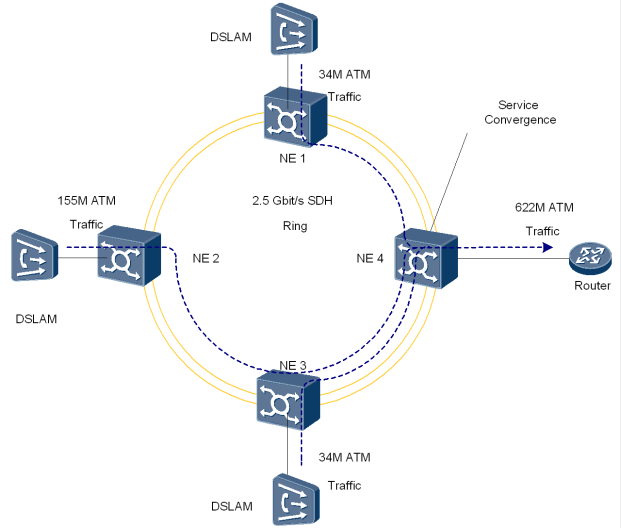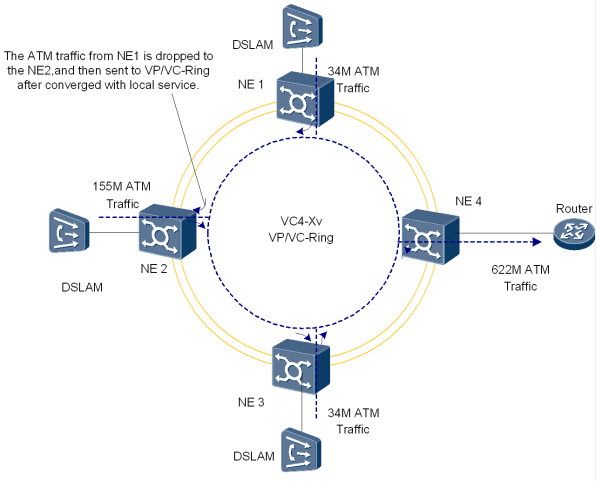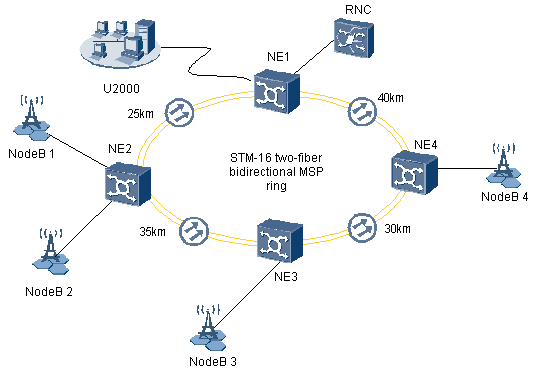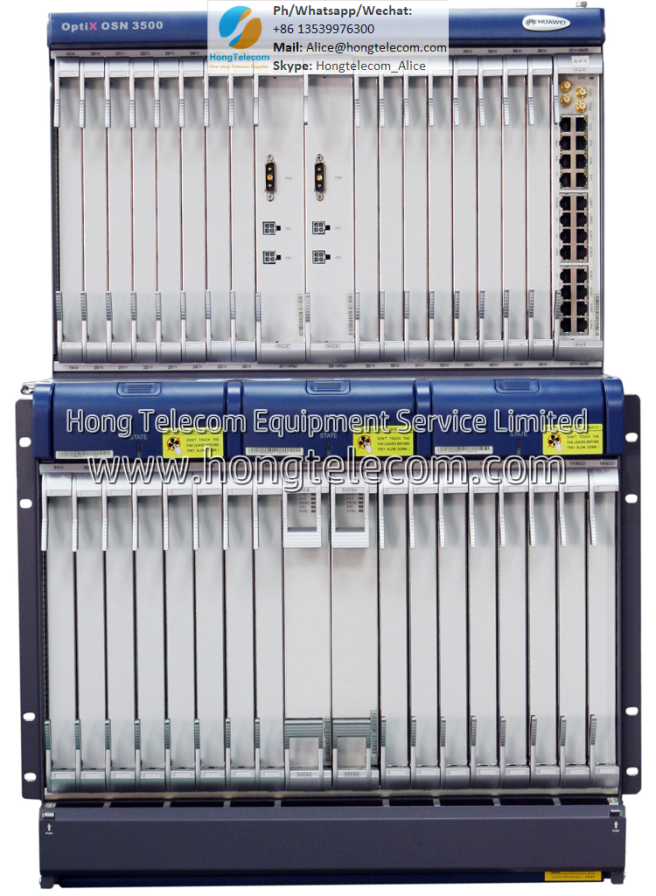The OptiX OSN 3500 supports the application of several types of ATM services.
Supported Services and Traffic Types
The OptiX OSN 3500 supports CBR, rt-VBR, nrt-VBR and UBR services, but does not support ABR services.
* The CBR services apply to voice services, and video services and circuit emulation services of a constant bit rate. These services require guaranteed transmission bandwidth and latency.
* The rt-VBR services apply to audio and video services of a variable bit rate.
* The nrt-VBR services are mainly used for data transmission.
* The UBR services are generally used for LAN emulation and file transfer.
In terms of the supported services and traffic types, the OptiX OSN 3500 meets IETF RFC2514, ATM Forum TM 4.0, and ATM Forum UNI 3.1 Recommendations.
ATM service types and traffic types
| No. | Traffic Type | Service Type | Parameter |
| 1 | atmNoTrafficDescriptor | UBR | None |
| 2 | atmNoClpNoScr | UBR.1 | Clp01Pcr |
| CBR | Clp01Pcr | ||
| 3 | atmClpNoTaggingNoScr | CBR | Clp01Pcr, Clp0Pcr |
| 4 | atmClpTaggingNoScr | CBR | Clp01Pcr, Clp0Pcr |
| 5 | atmNoClpScr | nrt-VBR.1 | Clp01Pcr, Clp01Scr, Mbs |
| 6 | atmClpNoTaggingScr | nrt-VBR.2 | Clp01Pcr, Clp0Scr, Mbs |
| 7 | atmClpTaggingScr | nrt-VBR.3 | Clp01Pcr, Clp0Scr, Mbs |
| 8 | atmClpTransparentNoScr | CBR.1 | Clp01Pcr, Cdvt |
| 9 | atmClpTransparentScr | rt-VBR.1 | Clp01Pcr, Clp01Scr, Mbs, Cdvt |
| 10 | atmNoClpTaggingNoScr | UBR.2 | Clp01Pcr, Cdvt |
| 11 | atmNoClpNoScrCdvt | UBR | Clp01Pcr, Cdvt |
| CBR | Clp01Pcr, Cdvt | ||
| 12 | atmNoClpScrCdvt | rt-VBR.1 | Clp01Pcr, Clp01Scr, Mbs, Cdvt |
| 13 | atmClpNoTaggingScrCdvt | rt-VBR.2 | Clp01Pcr, Clp0Scr, Mbs, Cdvt |
| 14 | atmClpTaggingScrCdvt | rt-VBR.3 | Clp01Pcr, Clp0Scr, Mbs, Cdvt |
Application of Bandwidth Exclusive ATM Services
When the bandwidth is not shared, ATM services are processed by the ATM service processing board, at the ATM layer of only the source and sink NEs. On intermediate NEs, only SDH timeslot pass-through is performed, without ATM layer processing. In this case, each ATM service exclusively occupies a VC-3 or VC-4 path. At the central node, the ATM services are converged to an STM-1 or STM-4 optical port for output.
As shown in below picture, the 34 Mbit/s ATM services of NE1 and NE3 exclusively occupy a VC-3 bandwidth each. The 155 Mbit/s ATM service of NE2 exclusively occupies a VC-4 bandwidth, and only the SDH timeslot pass-through is performed at NE3. After the three services reach the central station NE4, they are converged by the ATM board and are output through the 622 Mbit/s optical interface on the front panel.

Application of Bandwidth Shared ATM Services
The VR-Ring and VC-Ring realize the bandwidth sharing and the statistical multiplexing for ATM services. The ATM services on each NE share the same VC (VC-3, VC-4, or VC-4-xv) path and are processed at the ATM layer of all NEs.
As shown in below picture, NE1 accesses E3 ATM traffic from the tributary board and sends it to the ATM board for ATM switching and protection configuration (1+1 or 1:1). Then, after the traffic is encapsulated into VC-4-xv, it is sent to the line by the cross-connect board. NE2 accesses STM-1 ATM traffic from the optical interface, and then performs the ATM switching and protection configuration. At the same time, the ATM traffic from NE1 is dropped at NE2 for ATM layer processing. Then, the locally accessed traffic and the traffic from the upstream are encapsulated into the same VC-4-xv and sent to the downstream NE. The processing at NE3 and NE4 is similar. One VP-Ring/VC-Ring has a maximum bandwidth of 300 Mbit/s.

Application of IMA Services
The inverse multiplexing for ATM (IMA) technology is used to demultiplex an ATM integrated cell flow into several lower rate links. At the other end, the lower rate links are multiplexed to recover the original integrated cell flow.
The IMA technology is applicable when ATM cells are transmitted through an interface of the E1 rate or other rates. The IMA technology only provides a path, and does not process service types and ATM cells. The signals at the ATM layer and a higher layer are transparently transmitted.

Let’s have a look at the OSN 3500 S1012167 OADM Units:
03030eys TN11MR401 transplanting multiplexing plate with four road light (192.1/192.2/192.3/192.4 THz)
03030eyu TN11MR402 transplanting multiplexing plate with four road light (192.5/192.6/192.7/192.8 THz)
03030eyv TN11MR403 transplanting multiplexing plate with four road light (192.9/193.0/193.1/193.2 THz)
03030FBC TN11MR404 transplanting multiplexing plate with four road light (193.3/193.4/193.5/193.6 THz)
03030fbe TN11MR405 transplanting multiplexing plate with four road light (193.7/193.8/193.9/194.0 THz)
03030FBF TN11MR406 transplanting multiplexing plate with four road light (194.1/194.2/194.3/194.4 THz)
03030FBG TN11MR407 transplanting multiplexing plate with four road light (194.5/194.6/194.7/194.8 THz)
03030FBH TN11MR408 transplanting multiplexing plate with four road light (194.9/195.0/195.1/195.2 THz)
03030FBJ TN11MR409 transplanting multiplexing plate with four road light (195.3/195.4/195.5/195.6 THz)
03030FBK TN11MR410 transplanting multiplexing plate with four road light (195.7/195.8/195.9/196.0 THz)
03030FBS TN11CMR401 transplanting multiplexing plate with four road light (1291/1311 1291/1311 / nm)
03030FBT TN11CMR402 transplanting multiplexing plate with four road light (1391/1411 1391/1411 / nm)
03030fbu TN11CMR403 transplanting multiplexing plate with four road light (1471/1491 1471/1491 / nm)
03030FBV TN11CMR404 transplanting multiplexing plate with four road light (1511/1531 1511/1531 / nm)
TN11MR2-03070593 (C_EVEN, 100 GHZ)
03070770 TN11CMR2
03070222 SSN1MR
03070224 SSN1MR
